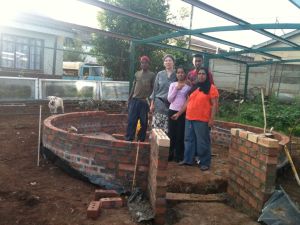This year South Africa nurtured two projects in the Sustainable Living vision of Shaykh Taner and Muzeyyen Ansari, one in Mafikeng, and one in Pietermaritsberg.
Human survival in these times is uncertain as Shaykh Taner assures us in his book “Surviving 2012 and Beyond”: climate change, economic problems/poverty, war, deforestation, homelessness and pollution are some of the world’s most pressing issues.
Yet these sustainable living projects, are growing in South Africa, a country which has experienced all of the above in recent years. In fact this may be why two different families, in two different towns, have recognized the need as real and tangible, not someone else’s problems far away, and have decided to do something themselves.
We are hoping that the Hoosen family and the Ghoor family themselves will contribute to this blog with their own news, but in the meantime some brief news and photos are posted here.
PIETERMARITSBERG: “A sustainable living center in their own backyard”
When Hoosen family moved into the neighborhood there was nothing on their land except pollution and trash. No one thought they could grow anything good on it. But patiently, with hard work, they worked with what they had been given; they removed the trash and stones and started planting, worm farming, and composting. Now the garden flourishes and they have been feeding their neighbors, the local community and shanty town children for years. By helping their neighbors irrespective of their race or religion, rich or poor, the danger that they first faced from local violence turned around too. There are security problems in South Africa, in neighborhoods like the Hoosens, where the haves and have-nots live side by side. But because of their generosity, their neighbors have rushed to protect them in times of danger, proving that the only real security is Love.
In the midst of this garden, they decided to build a brick dome, based on the model of “Rumi dome” by Nader Khalili, which is called Ansari Dome. While they were building last month, local officials stopped by to ask what was happening, and understood how the brick dome building could help AIDS orphans, abused or vulnerable children to find a safe place which no one could break into.
The Hoosen family are creating a sustainable living center in their own back yard. They aren’t waiting for big organizations or authorities to help them – they are just putting in their own efforts and “putting their money where their mouth is”, as they have always done in their journey of helping others less fortunate.
Along the way they are also training local young people in a useful skill. As I left, two young Africans were working with them, learning by doing. In the meantime, their own family are learning with all their senses what they have been doing anyway, but in another dimension of building a living space. A dome is a shell structure which is created in a circular pattern around the builder with the help of a guiding compass.
By building the dome themselves, they are cutting the costs drastically. But this is not the real purpose of doing the building themselves. Why is it important to build with our own hands? Not because we can’t afford to get someone else to build. Do people build because they are a lowly, laboring class kind of person? Not at all! It is a privilege to work with our hands. “Hands are the sail, body is the boat……” as the song goes. Hands are the direct connection with our sub-conscious, a connection with our soul. So in this work of building the Ansari Dome the builder connects directly with timeless forms and timeless materials, and learning by connecting the tangible and intangible.










